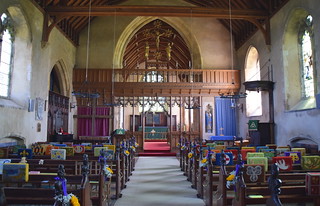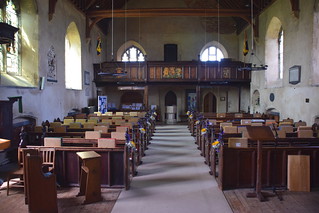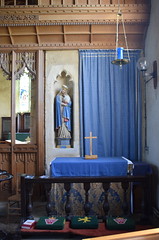| |
|
All
Saints, Mundesley There's
something charming about Mundesley. This is the caravan
coast of north-east Norfolk, but that in itself makes it
feel quite old-fashioned, and people like it for being
so. The wide North Sea spreads beyond the church, quite
as dramatic a setting as that of the more famous Beeston
Regis along the coast. The streets around have a seasidey
feel, with gift shops and fish and chip shops and a
bowling green, a skein of laughter caught by the wind,
the tattoo of an ice cream van . It was all very jolly.
This part of Norfolk was remote before the coming of the
railways, but by the second half of the 19th century this
beautiful coast had been discovered. You could reach here
in less than four hours from London, and so several
former fishing villages began to develop as holiday
resorts, becoming towns.
The most famous of these today is Cromer, but Mundesley
had ambitions too. When the railway reached here a couple
of massive hotels were built, and still stand today,
rather oddly in this backwater. Plots were laid out for a
a great housing estate, but the receding cliffs put
people off, and they never came. And the railway, too,
has gone now. Now, there are only the caravans.
It was the promotion of this part of Norfolk as
'Poppyland' in the early part of the 20th century that
led to the restoration of All Saints - until 1905, it was
just another clifftop ruin. Inside, a plaque records that
from this point eastward the nave and chancel of this
church were in ruins for over a hundred years. In
the early 19th century, Ladbroke had found All Saints a
ruin, but the western third of the nave roofed and still
in use - roughly, that part between the first and second
buttress from the west. Mundesley's reinvention as a
resort created a need for a new church, and so the ruin
was rebuilt, spectacularly well, in two stages. Firstly,
in 1904 the western end was extended to make an organ
chamber, and then in 1914 the nave was extended
eastwards, with a new chancel on the site of the old one.
From the outside, the most obviously 'old' feature is the
porch, although in fact a lot of old material seems to
have been reused in the new building.
You step into a church which is similar to nearby
Sidestrand which was rebuilt at almost exactly the same
time. There is a similar air of an early 20th century
High Church enthusiasm, but also a gentle, rural feeling.
For example, the vivid rood on the chancel screen is
balanced by a west gallery. The royal arms of Victoria
are on the front of the gallery. I couldn't decide if
they were painted directly on with a trompe l'oeil
effect, or actually made out of wood and stuck on.
The early 20th century glass is all by Kempe & Co in
the triumphalist manner of the day, the last gasp of a
style which within twenty years would have been utterly
replaced by simpler, starker styles. I'm not a huge fan
of the workshop, but it fits perfectly here, contributing
to a slightly dim prayerful space, a contrast with, but a
compliment to, the early 20th Century seaside village
outside.
Simon Knott, August 2019
Follow these journeys as they happen at Last Of England
Twitter.
 
    
|
|
|
